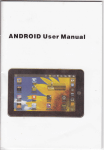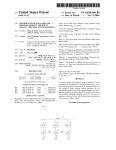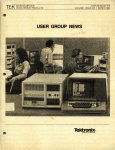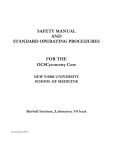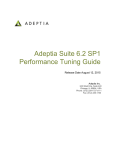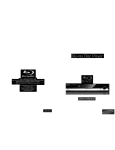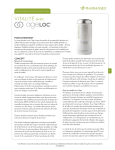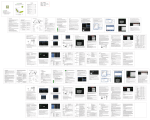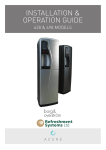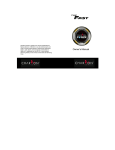Download tion Archive, and automatically deploying the Portal Appli
Transcript
US007716665B2
(12) Ulllted States Patent
(10) Patent N0.:
Buehler et al.
(54)
US 7,716,665 B2
(45) Date of Patent:
May 11, 2010
SYSTEM AND METHOD FOR DEVELOPING
2005/0257217 A1*
11/2005 Woollen ................... .. 717/177
gglTlg?Aérll’gk?gTlgggiggagigRTAL
2006/0020908 A1*
1/2006 Jain et al. ................. .. 717/101
APPLICATIONS INTO A PORTAL SERVER
APPLICATION
OTHER PUBLICATIONS
(75) Inventors: Dieter Buehler, Tuebingen (DE); Stefan
HePPer, Boeblingen (DE); Thomas
on JavaWorld, Aug. 2003, [retrieved online from http://WWW.
B0eb11ngen(DE)
javaworldcom/javaWorld/jW-08-2003/jW-080l-portel.htm1 on Dec.
_
_
_
_
11, 2008].*
(73) Asslgneez lcnternatlt‘fnalgrusmggsglgeggles
orpora Ion’
( >l< ) Notice:
Hepper et a; ., Introducing the Portlet Speci?ciaiton, Part 1, published
schaeFk, Achel'n (DE); Thomas stobel',
m0
’
(
)
BEA WebLogic Portal Deploying Portal Applicaitons, Version 8.1
With Service Pack 2, document Revised Feb. 2004. pp. l-52.*
Subject to any disclaimer, the term ofthis
patent is extended or adjusted under 35
USC_ 154(1)) by 1077 days
Endrel et al., IBM WebSphere V4.0 Advanced Edition Handbook,
chapter 20, Packaging and deploying Web services ; Chapter 19,
Depkloying an application page published on Mar. 2002, pp. 687
738.
21
( )
(22)
(65)
A
pp
1. N0.: 11/189 565
’
Flled:
(Continued)
Jul‘ 26’ 2005
Prior Publication Data
Primary ExamineriTuan Q Dam
Assistant ExamineriZheng Wei
(74) Attorney, Agent, or FirmiRaymond SZeto; Hoffman
US 2006/0036993 A1
(30)
Wamick LLC
Foreign Application Priority Data
Aug. 16, 2004
(51)
Feb. 16, 2006
(EP)
(57)
ABSTRACT
................................ .. 04103922
Int‘ C1‘
The present invention provides a system and method for
developing a Portal Application by creating a Portal Applica
G06F 15/16
E2006:01;
tion Archive, and automatically deploying the Portal Appli
(52) us. Cl. ..................... .. 717/175; 717/177; 719/328;
719/329; 709/250
(58) Field of Classi?cation Search ..................... .. None
See application ?le for Complete Search history
formin8 a coherent Portal APP lication, and an aPP lication
_
(56)
References Clted
component assembly descriptor Which speci?es hoW the
us PATENT DOCUMENTS
single application components need to be assembled to pro
*
vide the complete Portal Application on the Portal Server
6,892,382 B1
5/2005 Hapner et a1. ............. .. 717/174
6,986,135 B2 *
1/2006 Leathers et al. .
7,165,249
B2 *
2003/0172129 A1*
Canon Archlvelmo a Portal Server Apphcanon by “111g a
Portal Application Archive speci?c deployment mechanism.
The Portal Apphcanon Archlve_ represems en enmy Whlch
includes an assembly of all required application components
1/2007
Potter et al.
.....
Application~
717/177
. . . ..
717/174
9/2003 Moses et a1. .............. .. 709/219
12 Claims, 10 Drawing Sheets
35
Portal Application Deployment
65
Parilel Deployment
Portal Framework
91
JAVAEAR
Porllel
Aggregation
Portal Con?g
DB
Application
Portal Sewer EAR
55
65
70, 50
US 7,716,665 B2
Page 2
OTHER PUBLICATIONS
Anonymous: “JetspeediPortal Structure Markup”, Feb. 17, 2004,
John Methot, WebLogic Workshop Internals, WebLogic Workshop
pp.
1- l 3,
XP00237568 l,
http://Web.archive.org/Web/
200402 17 l 04646/http://j akarata.apache.org/j etspeed/ site/psml .
8.1, Feb. 17, 2004, pp. 1-31.*
European Search Report, Application No. 05105 889 .9-220 1, pp. 1-4,
Completion Date Apr. 5, 2006.
Anonymous: “Introduction to J SR l68iThe Java Portlet Speci?ca
tion”, Jul. 23, 2004, pp. 1-18, XP002375680, http://developersun.
com.
html.
R. Lynn, “Hello World, the simplest portlet for WebSphere Portal V5:
Part 2. Rendering with JSP”, Mar. 31, 2004, pp. 1-1 1, XP002375682,
http ://WWW- l2 8 . ibm.com/developerWorks/Web sphere/library/
techarticles/0403ilynn2/0403ilynn2.ht.
* cited by examiner
US. Patent
May 11,2010
Sheet 1 0f 10
US 7,716,665 B2
Dynamic Assembly Rule:
Only for Customers who own stocks
Application 1
Application 3
e.g. Stock
Info
e.g. Account Info
Appncation 2
Applicatl?" 4
e.g. Chat
e.g. Emall
User Interface Design (theme)
|
Application 5
Access Control
eig Mortgage
Defs (Roles)
C 'Culator
Utility Service
‘Eta-Application
ommumca ‘on
Access Control Setting:
Only for Elite Customer Group
FIG. 1A
_
US. Patent
May 11,2010
Sheet 2 0f 10
US 7,716,665 B2
Start
?l Develop application component LI/ 1
I Develop application component 2,/ 2
I Develop application component 3/ /3
Develop application component 4,I/ 4
IDevelop application component 5/ 5
I Develop utility Service 4/ 6
|
IPackage application component 1
I
IPackage application component 2
l
Package application component 3'
I
Package application component 4'
I
Delivered
Portal Application
IPackage application component 5 Consists °f3
|
i
. .
- 5 separate
.
I Package utility Service
application components
_ utility service
|—-———>
FIG. 18
(Prior Art)
US. Patent
May 11,2010
Start
Sheet 3 0f 10
US 7,716,665 B2
_
_+| Install appllcation component 1
1
I Install application component 2 ul/ 2
I Install application component 3 ‘I/ 3
Ilnstall application component4 ul/ 4
I Install application cmponent5 :I' 5
—|
Use Portal Layout Customizer
and arrange layout of the
6
installed application components manually
#
.
.
De?ne lnter
.
.
-appl|cat|on
/
communication between
7
/
application component 2 and 5
I
.. servlce
.
I Install ut|l|ty
—l
I /8
|
Install user interface
I/ 9
Design (theme)
I
10
/
I Define dynamic assembly rule
FIG. 16
(Prior Art)
Completion
I-——%
US. Patent
Start
May 11,2010
Sheet 4 0f 10
.
US 7,716,665 B2
.
1
Develop application component
Develop application component 21/
2
I
Develop application component 3 l/ 3
i
4
Develop application component 4i/
l
Develop application 5
Develop utility Service
I
/5
4/ 6
I
40
/
Application component assembly descriptor
I
I
Export an ,,Application Package “
(including an application component assembly descriptor
which can be generated automatically by the tooling software)
I Completion
Delivered ,,Application Package" consists of:
- 1 single complex Portal Application
50
(which embedds the individual appl./utility service)
- Application component assembly descriptor 40
FIG. 2A
35
/
US. Patent
May 11,2010
Sheet 5 0f 10
US 7,716,665 B2
Start
Automatically installing Portal
Application Archive into the Portal
Server in one step
Completion
-—-———>
FIG. 2B
US. Patent
May 11,2010
Sheet 6 6f 10
US 7,716,665 B2
35
15
,
12
14
\
13\
\
‘
16
J
I
l
/
1
Finance
Finance
Portlets
Pages & Nav.
Topology
17
\
\
Finance
URL
\ Template
Mappings
-
Collabo
ratlon
Portal
Appllcat
.
'0"
\
Mall I
Finance A
Portal _
Applicat \{
Calendar
Appllcatl
0"
Portal
>
.
\
Fmance
19
Application
18
20
Dynamic
/
JCA
AsBsenjbly for
Connector
prg'cs'gzgis
to Back End
Ion
\
‘
Portal Server
I
,
9Q
Business
1
Process Flow
Documents
Definition
Application Server
\
\
//
I
60
FIG. 3A
/
\
/
l
j
21
22
US. Patent
May 11,2010
Sheet 8 0f 10
US 7,716,665 B2
35
/
Portal Application
80
Archive
Application
Component 1
40
(AC1)
Application
Component 2
(AC2)
FIG. 3C
US. Patent
May 11,2010
Sheet 9 0f 10
US 7,716,665 B2
mm
E9628 m5
EiQcsmonE
w<058%
E_tno_n<
cm“on
on32wE
6
mmmm
mm
mm
US. Patent
M y 11, 2010
Sheet 10 0f 10
US 7,716,665 B2
N
m
o
.OEw
ow
uormu‘geq ewéqds eseé‘
vm
US 7,716,665 B2
1
2
SYSTEM AND METHOD FOR DEVELOPING
PORTAL APPLICATIONS AND FOR
AUTOMATICALLY DEPLOYING PORTAL
APPLICATIONS INTO A PORTAL SERVER
APPLICATION
speci?c components types, Which are all seWed together to a
coherent Portal Application produced by a large application
development team.
SUMMARY OF THE INVENTION
It is object of the present invention to provide a neW system
and method for developing a Portal Application and for
deploying the Portal Application into a Portal Server Appli
cation environment that avoids the disadvantages of the prior
BACKGROUND OF THE INVENTION
1. Field of the Invention
The present patent application relates to a system and
method for developing Portal Applications and for automati
cally deploying Portal Applications into a Portal Server
art.
In this patent application all components Which make up a
Portal Application are covered by the term “application com
Application.
ponents.” Such application components may be, for instance,
2. Background of the Invention
A Portal Server Application provides a ?exible framework
to produce very complex Web sites With very little effort. The
Files, Code+XML), Layout Design (e.g., Themes & Skins),
basic functional units of a Portal Server Application are Port
lets. Portlets can be considered as building bricks to create
individual Portlet Applications (e.g., embedded as WAR
Portlet Filters (Code+XML), Access Control De?nitions and
Roles @(ML), Dynamic Assembly Modules/ Conditions as
special case (e. g., Code+XML), Page/Navigation De?nitions
20
complex Web sites With sophisticated features. The Portal
Server Application aggregates the output of the individual
Portlets to an output Which can be rendered in a broWser. This
aggregation of content is a key feature of Portal Server Appli
cations, since it integrates the user interface (UI) of indepen
dent Por‘tlets nicely Without the need to Write any integration
code.
Each Portlet is a standalone unit of code, Which gets com
piled, packaged and installed independently. This is very
advantageous When integrating Portlets/Content from very
different Providers into a homogeneous Web site. There is
virtually no integration effort. The administrator of the Web
Server installation Will install each desired Portlet individu
ally and arrange the layout of the Portlet When designing the
Web site.
A disadvantage of this concept arises When a complex
Portal Application comprises more than one Portlet. For
instance an Online Banking Application could have many
multiple Portlets, for example an Account Portlet, a Stock
Price Portlet, a Stock Purchase Portlet, Email Portlet, a Loan
Portlet, and a Mortgage Portlet (see FIG. 1A).
Typically these Portlets can be developed and provided by
the application developer as part of a consistent Portal Appli
cation. Unfortunately the Portal Application developer can
not ship the Portal Application as a single coherent unit to his
customers. Instead he needs to ship his Portal Application as
individual pieces or so called Portlets. At the customer’s site
25
The present invention provides a system and method for
developing a Portal Application by creating a Portal Applica
tion Archive, and automatically deploying the Portal Appli
cation Archive into a Portal Server Application using a Portal
30
forming a coherent Portal Application, and additionally an
application component assembly descriptor Which speci?es
35
40
45
applications. A complex vertical J2EE application comprises
manifold base J2EE component types as Well as many Portal
cally deployed into the Portal Server Application environ
ment using a Portal Application Archive speci?c deployment
mechanism. The deployment mechanism evaluates the appli
cation component assembly descriptor information and
applies that information to the deployment process. The
present invention alloWs the development of complete Portal
Applications including pages, Portlets, communication chan
nels betWeen Portlets, etc., that can be deployed either out
of-the box or serve as a template that gets further customiZed
at deployment time.
50
BRIEF DESCRIPTION OF THE DRAWINGS
The above, as Well as additional objectives, features and
advantages of the present invention Will be apparent in the
folloWing detailed Written description.
55
The novel features of the invention are set forth in the
appended claims. The invention itself, hoWever, as Well as a
preferred mode of use, further objectives, and advantages
thereof, Will be best understood by reference to the folloWing
60
that platform, take advantage of neW capabilities and their
complexity is groWing as Well. Modern Portal Applications
comprise more than just a couple of Portlets. Further compo
nents can be added to produce even more sophisticated J2EE
hoW the single application components need to be assembled
into the complete Portal Application on the Portal Server
Application environment. The Portal Application Archive is
provided to the Portal Server environment and is automati
site layout. The installation of complex Portal Applications
becomes a very challenging and dif?cult task.
This problem becomes more signi?cant as the features of
Portals increase: Portal Applications, Which are developed for
Application Archive speci?c deployment mechanism. The
Portal Application Archive represents an entity Which
includes an assembly of all required application components
(Portal Server Application), each of the required Portlets of
the Portal Application needs to be installed and assembled
individually one after each other. The administrator must
perform all these installation steps for each Portlet and also
?nally de?ne hoW the Portlets should be arranged in the Web
(e.g., XML), URL Mappings (e.g., XML), Documents (e.g.,
XML Metadata+binary), Enterprise Java Beans, JCA Con
nectors (e.g., embedded as JAR-Files), Servlets (e. g., embed
ded as WAR Files), Portlet Utility Services, Included Web
Services, InterApplication Communication De?nitions (e. g.,
“Click-2-Action”), and J SF Components.
detailed description of an illustrative embodiment When read
in conjunction With the accompanying draWings, Wherein:
FIG. 1A shoWs an example of the structure of a Portal
Application,
FIG. 1B shoWs a prior art development process of a Portal
65
Application,
FIG. 1C shoWs a prior art deployment process of a Portal
Application,
US 7,716,665 B2
4
3
FIG. 2A shows the basic development process of a Portal
tion. Based on this meta information the Tooling SoftWare can
generate a machine-readable application component assem
Application according to the present invention,
bly descriptor 40 for the entire Portal Application and pack
FIG. 2B shoWs the basic deployment process of a Portal
Application into a Portal Server according to the present
age it together With the application components 1-5 as an
entity 35 called a Portal Application Archive. The content of
invention,
the application component assembly descriptor 40 is shoWn
FIG. 3A shoWs an example of a Portal Application that is
developed and deployed by the present invention,
in more detail in FIG. 4.
FIG. 3B shoWs an embodiment of the development and
deployment process of a Portal Application as shoWn in FIG.
FIG. 2B shoWs the basic deployment process of a Portal
Application as shoWn in FIG. 1A according to the present
invention.
3A according to the present invention,
The present invention makes all prior art deployment steps
obsolete. The entire Portal Application Which is represented
by the Portal Application Archive 35 is installed automati
cally in one step. The meta information included in the appli
FIG. 3C shoWs the result of the inventive development
process according to FIG. 3B,
FIG. 3D shoWs an implementation of a deployment process
in a Portal Server Application according to the present inven
cation component assembly descriptor 40 being part of the
tion, and
Portal Application Archive 35 can be evaluated by the Portal
Server Application deployment mechanism. Based on that
information the necessary deployment steps can be triggered
FIG. 4 shoWs an example of the content of an application
component assembly descriptor Which is part of the inventive
Portal Archive.
automatically. The Portal Server Application con?guration
DETAILED DESCRIPTION OF THE INVENTION
20
can be manipulated to re?ect the desired layout and interac
tion of the provided application components. The inventive
FIG. 1A shoWs an example of a complex Portal Applica
tion. The Portal Application (e.g., an Online Banking Appli
cation) includes multiple Portlets such as anAccount Portlet,
Stock Price Portlet, Stock Purchase Portlet, Email Portlet,
Loan Portlet, Mortgage Portlet, etc.
Typically, these Portlets can be developed and provided by
deployment process is shoWn in more detail in FIG. 3D.
FIG. 3A shoWs an example of a complex Portal Application
25
FIG. 3A shoWs an example With three different Portal
the application developer as part of a consistent application.
applications: collaboration 12, mail/calendar 13, and ?nance
HoWever, the application developer cannot ship the applica
tion as a single coherent unit to the customer. Instead he needs
developed by means of a Tooling SoftWare and deployed by a
deployment mechanism of the Portal Server Application
according to the present invention.
14. The ?nance portal application 14 includes a set of busi
30
to ship the application as individual Portlets. At the custom
ness process de?nitions 21, J CA connectors 20 to a backend
er’s side, each of the required Portlets needs to installed and
system, documents 22 describing the application for users,
page de?nitions 16, URL mappings 18 and templates 17. The
assembled individually one after each other. The administra
tor must de?ne all these installation steps and also ?nally
de?ne hoW the Portlets should be arranged on the Web site
Portal Applications pages are made available in the Portal
Server Application under the URLs de?ned in the URL map
35
pings 18. The contained dynamic assembly module 19 for
layout. The installation of complex Portal Application
business process pages ?lls in dynamic pages in a placeholder
becomes a very challenging and dif?cult task.
FIG. 1B shoWs a prior art development process of a Portal
Application such as that shoWn in FIG. 1A.
node in the Pages & Navigation Topology, depending on the
Each application component 1-5 is developed and pack
aged individually. Typically, each of these packages is repre
current state of business processes de?ned in the business
40
process de?nitions. The contained application Portlets 15
alloW the creating and processing of neW process instances.
They can display the contained documents for help or use the
sented as a separate ?le, e.g., a WAR ?le.
contained connectors to access backend systems. Some of the
The information Which de?nes hoW the individual appli
cation components need to be assembled by the administrator
at the customer’s site into a Portal Application is normally
contained Portlets are for administration of the Portal Appli
cation.
Within a Portal Application, based on its type, many appli
45
provided by a user manual.
FIG. 1C shoWs a prior art deployment process of a Portal
Application into a Portal Server Application environment.
cation components reference other application components.
For example, a node in a Topology tree can reference the
de?nition of a Page, a node in a Resource tree can reference a
In today’s Portal Server Application environment, the
administrator Would have to install each application compo
nent 1-5 individually. After installation he has to customiZe
50
In order to develop and deploy such a Portal Application
according to the present application neW function compo
nents have to be added to the existing prior art Tooling Soft
the Portal Application by manually arranging the application
components 1-5 as recommended by the application devel
oper. Additional deployment steps could be the installation of
certain services or the manual de?nition of interactions
Ware and to Portal Server 90/Application Server 60 as fol
55
betWeen application components.
loWs:
the Tooling SoftWare 30 (e. g., IBM Websphere Studio)
FIG. 2A shoWs the basic development process of a Portal
Application as shoWn in FIG. 1A according to the present
invention.
The present invention teaches that all individual applica
Theme de?nition, the de?nition of a Page can reference one or
more Portlets, etc.
needs to be able to support the notion of Portal Applica
tions, Which can be developed consistently and comprise
multiple individual, but related application components
60
internally,
tion components 1-5 are stored and/ or packaged together as
an entity (e.g., a single Java EAR File, a set of correlated ?les,
the Tooling SoftWare 30 must be able to package and export
a database record, etc.), Which includes all individual appli
cation components 1-5 forming a coherent Portal Applica
tion. The Tooling SoftWare de?nes meta information Which
includes interactions betWeen the application components
can be delivered by the application provider to the Portal
1-5 as Well as the desired layout of the entire Portal Applica
comprehensive Portal Application Archives 35, Which
Server Application. A key element is the application
65
component assembly descriptor being preferably a
XML ?le, Which lists the content of the Portal Applica
tion and de?nes hoW the content is assembled to provide
US 7,716,665 B2
6
5
lation betWeen both application components 70, 80. In the
a Portal Application application. For example, in an
J2EE environment, the package format of choice com
present example, the Portal Server Application deployment
prises J2EE EAR ?les, Which include all related appli
mechanism uses the application component assembly
cation components as Well as the deployment descriptor
descriptor 40 and creates a neW page With tWo columns.
Column 1 contains a single roW While column 2 contains tWo
roWs. Each of these roWs contains one application component
XML ?le,
the Portal Server 90 or the Application Server 60 on Which
the Portal Server 90 runs (e.g., IBM Websphere Portal)
must be able to import Portal Application Archives 35
and must automatically deploy the included application
7 0, 80.
FIG. 3D shoWs a preferred implementation of the inventive
deployment process in a Portal Server Application environ
components 15-22 as described in the application com
ment 90.
ponent assembly descriptor ?le 40. For example, this
deployment into a running Portal Server Application
Portal Application Archives 35 can be deployed directly
into the Portal’ s underlying Application Server 60 (AS) using
environment 90 can be done by using the Application
Server deployment. IBM WebSphere Portal Server 90
uses APIs in the Applications Server’s 60 deployment
process to properly handle all Portal speci?c application
components While the base J2EE application compo
nents are handled by the Application Server. Different
application components 15-22 in the Portal Application
Archive 35 in?uence the different parts of the Portal
Server 90. The deployed application components 15-22
plug into different Portal Server Application compo
nents, like the aggregation, the Portal con?guration or
its Application Server administration tools 65. Portal Server
Application 90 uses the APIs in the Applications Server’s
the Portlet Container (not shoWn).
The overall Portal Application development and deploy
deployment process 68 to properly handle all application
components 70, 80. FIG. 3D shoWs hoW the different appli
cation components 70, 80 in the Portal Application Archive
35 in?uence the different parts 91, 92, 93 of the Portal Server
Application 90. The application components 70, 80 plug into
20
container 93.
Within a J2EE environment, Portal Application Archives
35 Will be packaged as Java EAR ?les. As mentioned above,
25
ment process is shoWn in the FIG. 3B.
Portal Application Development Process
the Portal Application Archive 35 generated by the Portal
Tooling SoftWare 30 (or manually) Will be compliant to the
J2EE speci?cation and provide all necessary information
required by the standard.
Therefore the EAR (i.e., Portal Application Archive 35)
A Tooling SoftWare 30 for Portal Application 50 must
enhance the scope of a Portal Application according the
present invention. Instead of developing individual Portlets,
each project can include multiple application components
15-22, Which can be developed independently as individual
different Portal Server Application components, like the
aggregation 91, the portal con?guration 92 or the Portlet
30
can be deployed on any J2EE compliant Application Server
60. Nevertheless a standard Application Server 60 (AS)
Would ignore the additional information such as the XML
pieces of a Portal Application 50. In addition to existing
application component assembly descriptor ?le 40 and Would
tooling functionality, the relationship/interaction betWeen
not be able to determine hoW to assemble the various appli
different application components 15-22 of a complex Portal
Application 50 needs to be programmable as Well.
The Tooling Software 30 must also provide a layout editor
35
(not shoWn), Which alloWs de?ning of the layout of the Portal
Application 50 and arranging its application components
15-22 as desired.
Server 60. This is described beloW.
The controller of the existing Application Server Deploy
40
The developed application components 15-22 must be
ment API (knoWn as AppDeploymentController) accepts an
arbitrary J2EE EAR ?le as input, performs basic validation
for J2EE speci?cation compliance and then creates a
sequence of tasks that need to be performed for deployment of
stored Within the Tooling SoftWare’s internal repository as a
unit (not shoWn). It is important to emphasiZe that it is not
suf?cient to only store the developed code of the individual
application components 15-22. Additionally, the pro
cation components 70, 80 to the desired Portal Application
properly. For this purpose additional deployment logic (AS
Deployment 68) needs to be provided into the Application
the given EAR. The sequence of tasks can be extended pro
45
grammed relationship/interaction betWeen the application
grammatically to perform additional speci?c deployment
logic. Such an additional task Will be used to evaluate the
components 15-22 as Well as the de?ned layouts must also be
application component assembly descriptor 40 and perform
stored together With the actual code. For that purpose, it is
suggested that the Tooling SoftWare 30 uses the application
component assembly descriptor ?le 35 to de?ne hoW the
50
the necessary steps to deploy Portal Applications.
The AppDeploymentController instance is used by admin
istrative clients that provide application installation capabil
55
ity to the Portal Server Application 90. It reads an EAR ?le
and creates a sequence of AppDeploymentTasks Which
specify the data that needs to be collected from the end-user in
order to install the EAR ?le.
The controller class has the folloWing APIs among oth
various application components 15-22 are assembled into a
coherent Portal Application 50. The application component
assembly descriptor ?le 35 provides meta information (e.g.,
in XML) that describes the Portal Application 50 and its
topology. The ?le can be considered as the table of content of
a Portal Application 50 and also describes hoW to assemble
ersi
and arrange the application components 15-22. The structure
and content of the application component assembly descrip
tor ?le 35 Will be described in a more detail With respect to
FIG. 4.
60
class AppDevelopmentController
FIG. 3C shoWs an example of the result of the inventive
development process. The result of the development process
is the inventive Portal Application Archive 35. In the present
example the Portal Application Archive 35 is a single ?le
package that includes tWo application components 70, 80 in
machine-readable code as Well an application component
assembly descriptor 40 (e.g., XML ?le) specifying the corre
public String[ ] getAppDeploymentTaskNarnes( );
public AppDeploymentTask getFirstTask ( );
public AppDeploymentTask getNextTask ( );
public AppDeploymentTask getTaskByNaIne (String taskNaIne);
65
US 7,716,665 B2
8
7
The Portal speci?c tasks Which are added include:
The APls of AppDeploymentController class are docu
mented by AS 60.
According to the AS 60 speci?cation, a client application
lnstantiate Portlets;
Resolve external references;
needs to
Apply Themes/ Skins;
Add pages to the page hierarchy;
1) create an instance of AppDeploymentController using
AppManagementFactory and passing in an EAR ?le
2) iterate over the tasks created by AppDeploymentCon
De?ne Page Layout;
Setup access control settings/map users to roles; and
Connect Portlets using Click 2 Action Wiring Usage of
Portlets Within Portal Applications.
Portlets, along With Pages are the basic building blocks of
troller by calling getFirst and getNext methods
3) present the task data to the end-user and collects neces
sary data input by the user
4) set the data back into the tasks and saves the AppDe
ploymentController instance
5) call getAppDeploymentSavedResults APl on the con
15
troller to get options, and calls installApplicationAPl on
AppManagement MBean passing in the EAR ?le and
the options.
To deploy the Portal speci?c enhancements provided by
the EAR (i.e., Portal Application Archive 35), Portal Server
Portal Applicationsithey provide the sub-units of user expe
rience that are then aggregated by the Portal Application to
provide the ?nal user experience. Portlets are packaged into
Portal Applications. Portal Applications are similar to J2EE
Web applications, except they make use of additional inter
faces that make it easier to aggregate Portlets onto a single
Page, as Well as re-use Portlet applications and individual
Portlets on many Pages Within a Portal Application or Portal
20
site. The packaging format of Portlet applications is the Web
Archive (WAR) format that besides the Web.xml deployment
90 needs to implement its oWn Task Provider. Portal Server 90
descriptor includes the Portlet.xml deployment descriptor
uses APl(s) in the Applications Server’s deployment process
60 to properly handle all Portal speci?c application compo
that de?nes the Portlet relevant parts of the Web application.
A single Portlet produces the content of one Portlet Win
doW. In order to leverage the ?exibility that Portlets can be
nents While the base J2EE application components are
handled by the Application Server 60. The Portal speci?c task
25
provider can integrate additional deployment steps by imple
menting the interface AppDeploymentTaskProvider.
used as building blocks, Portlet application developers should
strive for small Portlets that contain a speci?c function
instead of one large Portlet that includes all functions. This
has several advantages:
30
package com.ibm.Websphere.managementapplication
public class AppManagementExtensions {
occupied by the parts not needed
* This interface is implemented by the task providers that Want
to add
35
Portlets
Portlets that belong to the same logical application should
*/
public interface AppDeploymentTaskProvider {
be bundled together in a Portlet application as this has several
/* >F
40
during
* set of default tasks to begin With.
* @paraln tasklnfo Vector that contains the task info
45
* @paraln deploymentlnfo The AppDeploymentlnfo instance that
FIG. 4 shoWs an example of an application component
locale,
assembly descriptor ?le resulting from the inventive devel
50
Vector tasklnfo,
preferably based on several XSD Schema de?nitions:
Base Schema De?nition 54
Describes the basic elements, Which are used in the other
AppDeploymentInfo deploymentlnfo,
Hashtable prefs)
throWs AppDeploymentException;
55
Based on the information in the application component
container.
schema de?nitions beloW,
Topology Schema De?nition
Describes all resources (J2EE references) and the applica
tion topology, including the layout, i.e., Page layout 57,
60
navigation trees 56, Portlets 55,
Security Schema De?nition 53
Describes security related aspects, such as application
roles and their access control rights.
Base Schema De?nition 54
tion Archive 35 in?uence the different parts of the Portal
Server Application 90. The application components 70, 80
plug into different Portal Server Application 90 components,
like the aggregation, the portal con?guration or the Portlet
opment process of a Portal Application.
The application component assembly descriptor ?le 40 is
public void provideClientDeployrnentTasks (
assembly descriptor XML ?le 40, Portal speci?c tasks are
invoked to register the application components 70, 80 Within
the Portal Server Application 90 and perform the necessary
Portal setup and administration steps automatically. The dif
ferent application components 70, 80 in the Portal Applica
preassemble complete Portal Applications like the described
invention. They miss the navigation and layout parts that are
needed in order to provide useful portal applications.
contains
* information about the archive being deployed
* @paraln prefs The preferences Where you can specify
* default binding info, etc.
*/
advantages, like the ability to share con?guration data, ses
sion data, and ease of deployment and administration over the
approach of one Portlet per Portlet application.
HoWever, Portlet applications are currently very limited as
they only deal With the Portlet part and do not alloW to
* creation of AppDeploymentController instance. The vector
contains a
objects
limited device display capabilities
additional functions can later simply be added as neW
* on the client side.
* Manipulates the list of task info objects that are used
on the page and save space that otherWise Would be
the different functions can be split across portal pages to
suit the Working behaviour of the user or to adapt to
/* >F
* extra tasks to the app deployment (preparation of ear ?le)
process
the portal end-user can decide to only put the needed parts
65
The base schema de?nition speci?es basic elements Which
are used in the other tWo schema de?nitions. These
elements include:
US 7,7l6,665 B2
9
10
Title:
A friendly name of an entity to be exposed to the program
Static
dynamic
Layout Tree 57
This is the root element of Layout Tree, Which describes all
mer or user.
Description:
The description element provides a NLS-enabled text
available layout templates. The layout tree element provides
Parameter:
A set of name/value pairs Which alloW to attache custom
iZed attributes to an entity
nlsRef:
A reference to a ?le, Which can map localiZed strings.
directly a particular layout element.
Layout Element
The layout element describes a Layout Template. Besides
title, description, parameters, unique Name and a keyWord,
a title, description and can reference other layout trees or
Version String:
the layout element includes a container in Which content can
An identi?er to specify the version of an entity
be placed.
The Topology description schema comprises three parallel
Container
The container element can include several containers itself,
trees 55, 56, 57 Which are linked to each other:
The application tree lists and describes all application com
or it can be used to place actual content into a layout.
ponents, Which are used by the Portal Application.
Application components can be speci?ed in a hierarchi
Unique name, title, description and parameters are addi
cal order in that tree 55.
The layout tree de?nes the layouts Which can be used by the
Portal Application 57. Layouts can be included in other
20
layouts. Layouts specify WindoWs in Which application
components can be inserted.
The navigation tree de?nes the navigation hierarchy Which
the application exposes 56. This is done by de?ning
navigation elements, Which map the given application
25
A WindoW is the Placeholder into Which actual content can
be placed into a layout: such content can be either:
30
A reference to another layout element, Which is embed
ded into the WindoW of the given layout element
A static reference to an application entity Which is
placed into the WindoW as part of the layout de?nition.
An empty spot, indicating that this WindoW is free to be
35
used by a navigation element using the given layout
element. Each navigation element using this layout
element can specify individually Which application
entity should be placed into this spot.
Navigation Element 56
components to particular WindoW in the available lay
outs.
The folloWing list details the elements Which are de?ned in
the Topology Schema De?nition:
Topology Description 55, 56, 57:
This is the root element of the topology description. It
includes the application title, description, version,
unique name, and its prerequisites. This element also
references the application tree, layout tree as Well as the
navigation elements Which combine application compo
nents and layouts.
Application Tree 55
Navigation elements are nested and resemble the naviga
tion tree, Which the application exposes to the user. Each
This is the root Element of Application Tree, Which
navigation tree can have one or more sub navigation
describes all application components.
This element provides a title, description and unique name.
An application tree can reference other sub-application
elements. The referenced navigation content Within the
40
Navigation Content
The application element describes an application compo
45
unique name, a resource-link element references the
binary code (e.g., a WAR ?le). Parameter name/value
pairs can be used to provide application speci?c infor
50
Portletde?nition
The invention claimed is:
Portletentity
application component (e. g., a WAR ?le). UID and URL
are used for referencing. There are tWo link types, Which
can be applied:
corresponding WindoW Within the given layout are ref
erenced. The application entity Will shoW up in that
layout WindoW, When the Portal Application is dis
played.
This type lists all possible application element types:
Wire
Portletservice
service
skin
theme
label
urlLink
tile
any
Resource Link
This element references the actually binary code of an
The navigation content is used by the navigation element to
map content (application entities) into a particular lay
out. For this purpose a particular application entity and a
mation.
Application Component Type
navigation element speci?es hoW content is placed into
the used layouts.
The layout element as Well as Title, description, and
parameters are speci?ed Within the Navigation element
trees or directly one or more application elements.
ApplicationElement
nent With its properties. Besides title, description and
tional information documented in the container element. The
folloWing container types are possible: roW
Column
Grid
WindoW
Title, description, and parameters are used Within the Win
doW element.
1. A method for automatically deploying a Portal Applica
tion into a Portal Server Application environment, Wherein
55
the Portal Application is provided to the Portal Server Appli
cation environment as a Portal Application Archive Which
60
includes all application components in machine-readable
code for forming the Portal Application, Wherein the all appli
cation components include portlets, each portlet containing a
speci?c function, and the Portal Application Archive also
includes an application component assembly descriptor in
machine-readable code Which speci?es hoW the application
components need to be assembled to provide the Portal Appli
cation on the Portal Server Application environment, the
method comprising:
providing the Portal Application Archive to a deployment
mechanism Within the Portal Server Application envi
US 7,716,665 B2
11
12
ronment Which is able to directly deploy the Portal
Application Archive into the Portal Server Application
describes all the single application components, a layout
tree that de?nes the desired layout by de?ning Which
environment by using the deployment mechanism’s
Application Program Interfaces (APIs) to properly
WindoWs application components are inserted into, and a
navigation tree that de?nes navigation elements that
map the application components to a particular WindoW
in the desired layout,
means for storing the single application components and
handle the all application components,
evaluating the application component assembly descriptor
included in the Portal Application Archive by means of
the deployment mechanism to determine a desired lay
out of hoW the application components need to be
assembled and interaction information of all the appli
the application component assembly descriptor together
10
cation components, Wherein the application component
assembly descriptor includes a topology schema de?ni
tion, the topology schema de?nition including an appli
as a Portal Application Archive into a repository, and
means for providing the Portal Application Archive to a
deploying mechanism of the Portal Server environment
for automatically deploying the application components
directly into respective parts of the Portal Server Appli
cation environment by using the deploying mecha
nism’s Application Program Interfaces (APIs) to prop
cation tree that lists and describes all application com
ponents, a layout tree that de?nes the desired layout by
de?ning Which WindoWs application components are
inserted into, and a navigation tree that de?nes naviga
to the desired layout and interaction information
tion elements that map the application components to a
included in the application component assembly
erly handle the single application components according
descriptor.
particular WindoW in the desired layout, and
automatically deploying the application components into
20
respective parts of the Portal Server Application envi
tion environment as a packaged single ?le, a packaged subset
ronment according to the desired layout and interaction
information included in the application component
of correlated ?les, or in a database record.
assembly descriptor.
2. The method according to claim 1, Wherein the applica
tion component assembly descriptor is a XML descriptor ?le.
3. The method according to claim 1, Wherein the applica
tion component assembly descriptor further includes base
schema de?nitions and security schema de?nitions.
4. The method according to claim 1, Wherein the Portal
10. Tooling SoftWare according to claim 9, Wherein the
25
providing the Portal Application as a Portal Application
Archive to a Portal Server Application environment
30
35
40
machine-readable code Which speci?es a desired layout
of hoW the application components need to be assembled
and includes interaction information of the application
components to provide the Portal Application on the
Portal Server Application environment, Wherein the
6. The method according to claim 1, Wherein the deploy
ment mechanism is con?gured to instantiate application com
ponents, resolve external references, apply themes/ skins, add
pages to a page hierarchy, de?ne page layout, set up access
application component assembly descriptor includes a
topology schema de?nition, the topology schema de?
components.
7. A computer program product stored on a computer
nition including an application tree that lists and
describes all application components, a layout tree that
usable medium, comprising computer readable program
means for causing a computer to perform the method accord
ing to claim 1.
including the Portal Server, Wherein the Portal Applica
tion Archive includes all application components in
machine-readable code for forming the Portal Applica
tion, Wherein the all application components include
portlets, each portlet containing a speci?c function, and
an application component assembly descriptor in
5. The method according to claim 1, Wherein the deploy
ment mechanism is controlled by the Application Server on
control settings, map users roles, and connect application
single ?le is a Java EAR ?le.
11. A method of deploying a Portal Application on a Portal
Server, the method comprising:
Application Archive is provided as a Java EAR ?le, a set of
correlated ?les, or database record.
Which the Portal Server Application runs.
9. Tooling SoftWare according to claim 8, Wherein the
Portal Application Archive is provided to the Portal Applica
45
de?nes the desired layout by de?ning Which WindoWs
application components are inserted into, and a naviga
tion tree that de?nes navigation elements that map the
application components to a particular WindoW in the
8. Tooling SoftWare for developing a Portal Application
stored on at least one computer useable medium, the Tooling
SoftWare comprising:
means for developing single application components,
Wherein the single application components include port
lets, each portlets containing a speci?c function,
50
means for developing an application component assembly
descriptor Which speci?es a desired layout hoW the
single application components need to be assembled and
includes interaction information of the single applica
tion components to provide the Portal Application on the
Portal Server Application environment, Wherein the
55
desired layout; and
means for automatically deploying the application compo
nents directly into respective parts of the Portal Server
by using Application Program Interfaces (APIs) to prop
erly handle the all application components according to
the desired layout and interaction information included
in the application component assembly descriptor.
12. The method according to claim 11, further including an
Application Server on Which the Portal Server Application
environment runs, Wherein the means for deploying the Portal
application component assembly descriptor includes a
topology schema de?nition, the topology schema de?
Application is part of the Application Server.
nition including an application tree that lists and
*
*
*
*
*



















